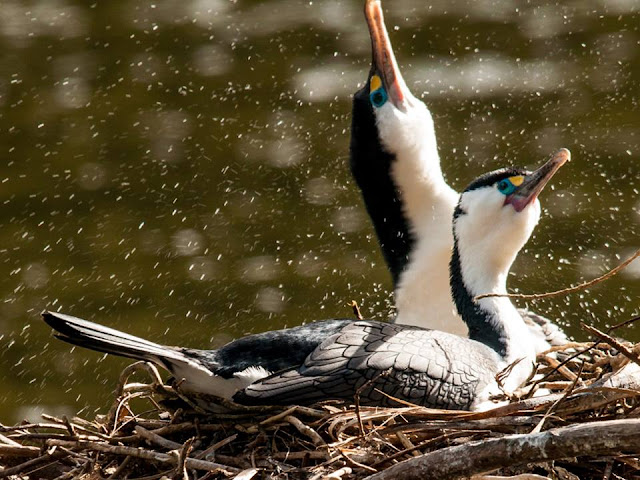 |
| Kaka allopreening. Photo by Judi Lapsley Miller |
The kaka at Zealandia are getting frisky. We have been allocated our nest boxes to monitor. Each group of nest boxes gets checked twice a week by a couple of people who share the responsibility. I am the designated midweek monitor, though we did our first check together to acquaint ourselves once more with the routine. The nest boxes are attached to trees off track so we were given maps to track them down. The first couple of trips to find them can take a little more time as we get our bearings.
The first kaka eggs have been laid, but not on our patch so far. But we do have kaka checking out our boxes so here's hoping.
I went in again this week for my first solo run. As I was also taking the takahe talks later in the day I went in early to get their food weighed out so that I would not have to return to the Ops shed.
As I walked up I stopped to see how the karuhiruhi were doing on their very very visible nest by the pontoon. No eggs yet as far as I could see but the happy couple of pied shags were sitting there dozing in the warm spring sun. They are very elegant close up with their black and white colouring and bright blue eyes with a yellow patch in front. To me it is not the best place to build a nest as it is close to the water and very exposed to northerlies. Tucked around on the sheltered side though I spied a new nest being built. This seemed to be a solo parent's effort as I have not seen a partner. The nest seems a bit of a scruffy stick and twig affair so far but maybe time and a mate will improve it.
 |
| No eggs yet for the karuhiruhi photo from Alfie Kakas blog |
 |
| Note their beautiful eye colouring . photo from Alfie Kakas blog |
 |
| Pied shag nesting behaviour. Photo by Alfred Kaka |
At the first stop not much was doing. The twig that we had placed across the nest entrance had gone and there was signs that kaka had been inside as there was new material added to the wood chips we had provided and some of the wood chips had been tossed up on a ledge. But of the kaka there was no sign.
At the next stop I heard calling high up in the trees. I grabbed my binoculars to see if I could read the bands but the two birds were directly above me and not showing their legs. They were pulling at pine cones together. They flew down a little lower and were indulging in a little allopreening when a third swooped down to join them. This caused them all to fly off with much screeching. It was frustrating not to sight any bands. Again the nest showed signs of kaka interest but their were no eggs.
I was busy at the third nest cutting a suitable twig to replace the missing one across the nest entrance when I glimpsed a movement above me and there was a kaka climbing down the tree to investigate what I was up to. I put the secateurs on the top of the nest box and the kaka jumped onto the roof to get a closer look at the secateurs and at me. I stood quietly while it eyeballed me and looked hopeful that I might produce something more interesting and maybe edible. I mentally tried to record the leg bands that were right in front of me. Read the bird's left leg first from top down, and then the right is the correct method. Once it had had a good look at me it flew away showing me its beautiful red colouring under the wings. I rushed to write down the bands but in my excitement got confused about which leg had what colour where. Keeping clam and writing them down correctly is a skill I will have to practise. But it was a thrill to see a wild bird so close and on its own terms. Its colouring was just gorgeous - a mixture of subtle greens and browns which change in different light.
 |
| Kaka colouring tends to change with light from olive to russet brown |
The last nest had the twig removed showing kaka had been about but all was quiet as I watched so I headed down to find a quiet spot to have lunch before my takahe talks.
 |
| I have great respect for that beak! |
The takahe were on cue awaiting my arrival. The visitors had a laugh as they chased me to the feeding hoppers and then got stuck in to the pellets. There is always the chance my finger might be mistaken for a pellet and the knowledge those big beaks can draw blood keeps me alert. They were looking in fine fettle, their plumage looking iridescent in the sun. They are a great draw-card for visitors who just love their lack of fear of people as they wander round under their feet. I answered the many questions then sat and relaxed for a while in the spring sunshine before making my way out of the valley once more.
 |
| Kaka like to strip bark in search of insects and sap |

No comments:
Post a Comment